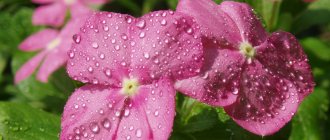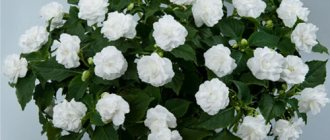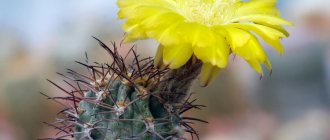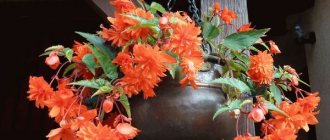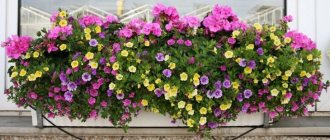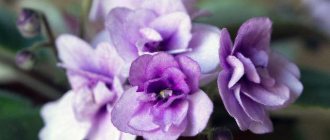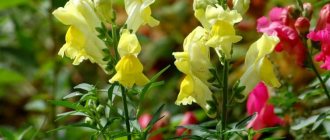In recent years, decorating private courtyards, balconies, and loggias using hanging plants has become increasingly popular. Impatiens or impatiens is in high demand because it is considered an unpretentious flower that does not require special conditions, moreover, it blooms lushly throughout the summer, and the variety of colors and shapes of inflorescences can amaze anyone. Any inexperienced gardener can master the basic principles of planting and caring for impatiens, which is why this plant has not lost its popularity for many years.
Balsam can be purchased ready-made in a hanging pot, but it is much cheaper and more interesting to grow it yourself. Previously, professional hybrids were available only in the form of cuttings, so the average summer resident did not have access to them. But now there are seeds of varieties on sale that are highly decorative and are in no way inferior to plants purchased at garden centers.
Impatiens ampelous: description of the plant
Impatiens is a herbaceous shrub with large, erect stems. The plant's nutrition comes from a large rhizome. The shoots grow quickly and form a spherical bush up to 45 cm high. If the humidity is high, small granules similar to grains of salt appear on the stems.
Plant in a pot
The petals are attached to the stems on small petioles and are oval or ovoid in shape. The size of each petal is approximately 9-14 cm. The edges of the petals are covered with small teeth, and on the surface there is a relief pattern of veins. The leaves are mostly green, but sometimes have a purple tint.
The first flowers begin to grow in early spring and replace each other until mid-winter. The color of the leaves can be bright red, pink, emerald, purple, blue, lilac, orange. There are also species with the usual 5-petaled flowers in the shape of an open bell. There are now many varieties of velvety-looking plants on the market whose flowers look like a small rose.
For your information! A small berry grows in place of the flower. She is very sensitive to touch. Any vibration causes the berries to open and numerous seeds immediately fall from them.
More about the flower
Impatiens (often called impatiens or impatiens) is a genus of herbaceous plants with approximately 500 species. Distinctive features of the flower: solid fleshy foliage of green or red-green color; branched shoots, the height of which can vary in the range of 15-50 cm. Scientists say that the birthplace of balsam is Asia and Africa. Now the plant actively grows in the temperate and tropical zones of Europe and North America.
During the flowering period, beautiful single flowers appear on impatiens. They rise above the foliage, which is why the bush strongly resembles a lush bouquet. The impatiens plant blooms at home for 6-7 months. On open ground - from June until the first frost. Growing in optimal climatic conditions, impatiens can bloom all year round.
As for the balsam fruits, they are quite juicy and have an oblong shape. They contain a relatively large number of seeds - on average 100 per 1g of weight.
Planting and care
Impeller balsams in landscape design
Plants do not require complex care. This unpretentious flower adapts well to environmental conditions and blooms for a long time. But, like every other decorative flower, it needs some care. Next, the necessary care for impatiens will be discussed.
How to care for a young plant
Planting and caring for impatiens impatiens consists of elementary stages: proper planting, fertilizing and sufficient watering.
Humidity is one of the important processes when growing a flower. At a temperature of 25°C it should be moderate. But the higher the temperature in the room, the more water vapor there should be in the air, so the impatiens stems are rinsed. This action is very important for the development of the plant. The bush should also be watered moderately, but the soil in the pots or cache-pots should not dry out. In summer, the volume of water for the flower increases.
Fully mature bush
These flowers tolerate some shade well, but in sunlight the petals become juicier, and a huge number of buds appear on the bushes. They are not afraid of direct sunlight, and in dark rooms the flowers stretch out and fall off. You can plant in hanging pots, deep and not very large garden and balcony boxes and vases with a volume of 2 liters or more.
Note! Any fertile soil is suitable for the plant. If these are vases, then it is recommended to line the bottom with stone chips or expanded clay.
When the bushes begin to grow and bloom quickly, they require fertilizing. Several times a month during watering, it is necessary to dilute mineral fertilizers in water, which are intended for flowering balcony and garden plants.
Reviews
- Katerina, 26 years old: “I fell in love with balsam in one of the flower shops, but the price for an adult plant at that time was too high for me, and I decided to grow it myself. I bought seeds in the same store, they were securely hidden in a paper bag that contained a capsule, it contained several small seeds, they were so airy, I was afraid that in any draft they would fly off the pot, because digging them in when planting is not recommended. After the first watering of the soil with a spray bottle, the seeds themselves were pressed into the ground. The first shoots appeared after about three weeks, I already began to worry that they had not sprouted at all. After they grew and were decorated with wide leaves, I transplanted them into peat cups. Some had to be planted in twos because I couldn’t separate their roots. As a result, on my balcony there were three hanging flower pots with hanging thick branches, densely strewn with flowers.” But you can find out what reviews of Balsam Camellia exist by reading this article.
- Olga, 54 years old: “In a garden store I liked a bag of seeds of the terry ampelous balsam variety “ATENA APPLEBLOSSE F1.” There were only 8 seeds in it. Since I had never sprouted seedlings for flowers from seeds, I approached this process with all seriousness. I prepared a special mixture, poured it into a shallow container, and placed the seeds in two rows at a decent distance from each other. Periodically sprayed the ground. And when the entrances appeared, I carefully watched to see that three leaves appeared on them, then transplanted them into small disposable plastic cups. Of the eight seeds, I got five. As soon as the seedlings got stronger, I immediately planted them in hanging pots and hung them on my balcony, it’s glassed, so it’s been decorated with balsam since May.”
Pests, diseases and prevention
What are ampelous plants and ampelous annual flowers?
The most common ailments that can cause significant harm to the plant:
- Balsam mosaic. Fresh leaves deteriorate and yellow specks form on them. Over time, the spots grow and already affect the stems of the bush. If the disease is not treated in a timely manner, the plant will stop blooming and die. There is no point in carrying out treatment, so you need to immediately pinch off the affected parts. In the case of this disease, prevention is of great importance: only constant spraying of the plant with an insecticide will help prevent the development of the disease.
- Gray rot. Brown spots form on the petals and shoots of the flower, which over time turn into gray fungal areas. Affected plants mostly die. Causes of the disease: watering with contaminated water or using tools that have not been cleaned. Methods of control: preventive care, as well as strict adherence to watering and fertilizing times. If signs of infection with the disease are noticed, it is urgent to remove the affected parts of the flower and spray it with foundationazole.
Fundazol
- Bacteriosis. Watery specks form on the leaves and shoots and grow quickly. If the infection is ignored, the flower will die. Causes of the disease: very hot place of detention and lack of nutritional components. Methods of control: you need to cut off the affected parts and spray with Bordeaux mixture.
- Powdery mildew. A light coating forms on the petals of the hanging plant. Cause of the disease: severe temperature changes, insufficient air in the room, poor quality of feeding. Methods of control: you need to cut off the painful petals and spray the flower with fungicides (experienced gardeners recommend the drug Bayleton).
Important! Among the pests, the flower is loved by whiteflies, aphids and spider mites. To combat them, petals and stems need to be washed with soapy water. In severe situations, it is advisable to treat the bush with insecticides.
Balsam family – Balsaminaceae
A beautiful flowering plant. Impatiens are also known under other common names: evergreen, sparkle, and impatiens. They all reflect different features of this plant. The genus balsam includes about 400 species in total. The variety of balsams is so great that it is difficult to give them an accurate general description - they are annuals, perennials, herbaceous, and semi-shrub forms. The stems of balsams are juicy, fleshy, often translucent - in this way they resemble succulents.
Ampelous impatiens
The most popular hanging varieties:
Impatiens ampelous Highlight F1 Deep Orange
Ampelous unpretentious perennial flowers for the garden
Advantages of the plant for home planting:
- professional impatiens for hanging baskets, to be sown in open ground;
- forms a continuous flowering ball;
- a very long flowering plant: from June until frost in October-November;
- tolerates rain and bad weather;
- It is recommended to grow in places with diffused sunlight.
For your information! Previously, hybrids of such a high level were only available from cuttings. Although this biotechnique of propagation is convenient, plants did not always take root using cuttings. The Highlight series is characterized by very short internodes, which creates a very dense bush and dark leaves, against which the flowers look even brighter.
What to consider when landing:
- germination: 10-15 days at 20-25°C;
- seedlings: 7-8 weeks at 18-20°C;
- landing at a permanent place: the first ten days of June;
- Beginning of flowering: 15-16 weeks.
Impatiens ampelous Acrobat
Another name for this old variety is Vanka wet. It is so called because small drops of moisture appear along the edges of the petals. Gardeners also call it balsam pelargonium. Flowers of bright color stand out against the background of swamp leaves.
Powdery mildew disease
This variety is perennial. The bush is quite branched and has thick stems. Swampy or red-brown petals of small diameter, oval in appearance. White, red or light pink flowers are located at the ends of the branches. If you follow the rules of care and planting, this plant will bloom all year long, and in warmer times they can be used as a decoration for flower beds.
The plant does not like bright direct sun; it is advisable to choose a little partial shade. With scattered rays, the flowers become brighter in color. Supports or wings give the plant protective properties from rainfall. The beautiful shape of this species looks good in hanging planters. This is a strongly branching bush, strewn with flowers with shoots of 25 cm.
Important! It begins to bloom from the beginning of summer until the first frost. The Ampelous Acrobat is famous for its rapid growth. For a hanging flower pot, one lush flower is enough. Flowers are renewed each time and become stronger than the previous ones. Tolerates bad weather conditions well.
Impatiens ampelous is almost easy to care for, but it does require care. You cannot place the flower in direct sunlight, otherwise it will quickly die. This plant is quite popular on the market; experienced gardeners recommend using it as a decoration in pots.
Varieties
On sale you can find different varieties that differ in the color of the leaves, the type and color of the inflorescences, and the length of the stems. There are drooping forms that hang from the lawn, and there are those that form a dense and tall ball over a hanging planter.
At the moment, two varieties of hanging balsam are considered the most beautiful and stable: “Highlight” and “Acrobat”. Both of them are hybrids, so it will not be possible to reproduce them from the seeds of an existing impatiens: the daughter plant will not show all the signs.
“Highlight” is represented by the following varieties:
- "Burgundy";
- "Coral";
- "Red Star";
- "Salmon";
- "Deep Orange"
The “Acrobat” variety has the following hybrids:
- "Rose";
- "White";
- "Purple Star"
When choosing planting material, you need to pay attention to these hybrids, since they were bred by breeders for hanging cultivation.
Burgundy
Coral
Red Star
Salmon
Deep Orange
Rose
White
Purple star
Reproduction methods
Growing from seeds
In Waller's balsam, a fruit-box forms in place of a wilted flower. If you even lightly touch it, it will open and a large number of small seeds will spill out, which remain viable for about eight years.
The substrate used for sowing must be disinfected and sifted. To do this, you can use a mixture of sand and peat or garden soil with sand. As a rule, seeds are sown in April or May, but some varieties can be sown as early as January (for example, New Guinea).
Instructions for sowing Waller's balsam:
- Small containers are filled with prepared soil mixture, after which it is moistened with a sprayer.
- Distribute the seed material over the surface of the substrate. The distance between seeds should be approximately 30–40 mm.
- The seed material is covered with a thin layer of sifted soil mixture or sand on top.
- Moisten the crops and cover them on top with film or sand.
The first seedlings should appear after just 5–15 days. Picking is carried out after the bushes have reached a size of 10 mm, and they should have formed a pair of true leaf plates. If you want young bushes to bloom in the summer, then they should be sown in the first days of March.
Waller's balsam. Growing from seeds.
Cuttings
The easiest and fastest way to propagate such a crop is by cuttings. To do this, in May or June, healthy and well-developed bushes are placed in the shade for a short time. After the shoots on the plant begin to stretch, they should be trimmed and placed in water for rooting. Next, the rooted sections are planted in separate pots filled with a slightly acidic soil mixture.
Cuttings can be carried out at any time of the year as needed. If the bush is grown in the summer, then it will delight with its flowering even in winter.
Important! Young bushes need high-quality lighting. Otherwise, this will lead to strong elongation of the shoots, weakening of the plant itself and a lack of flowering.
STEP-BY-STEP INSTRUCTIONS FOR ROOTING BALSAMS
Watering
The plant is moisture-loving. You can't wait for the soil to dry out. But stagnation of moisture in pots should also be avoided. Water the flowers after sunset. It is good if it is possible to complete each watering by mulching the soil and removing weeds.
Important: damaged and wilted inflorescences must be removed. It is also recommended to pinch the tops, which will make it possible to form a beautiful bush.
Step-by-step instructions for growing
A shallow pot is required for planting. The use of containers with a depth of more than 8 cm is not recommended, since the root system is located superficially and stagnation may begin in the deep layers.
The pot should not be too spacious. The closer the roots are, the more the budding process is stimulated. The soil, like the pot, must be treated with Fitosporin to destroy bacteria that lead to the disease “blackleg”. Canopy plants are especially sensitive to this infection.
Hybrid balsams
Flat, spur-shaped flowers 2.5–5 cm in diameter are formed at any time of the year, as long as the temperature does not drop below 16°C. The flowers are mostly red, orange, pink, white, many are multi-colored, and some are double. Small pale green leaves on a brittle stem. Hybrids from New Guinea have large, more lanceolate, bronze or variegated leaves and are usually taller, reaching 30–60 cm. The flowers of hybrids from New Guinea are usually few in number, but larger.
Impatiens grown indoors create a special, joyful mood with their bright colors. In winter garden compositions they are attractive with their bright color spots. Impatiens are popular not only as profusely flowering indoor plants - their numerous varieties and varieties decorate balconies and flower beds in the garden in the summer.
Possible problems
If Waller's balsam is not cared for correctly, the following problems may arise with it:
- The foliage begins to wither and flies away . This is due to too little and infrequent watering or the room is very cold (below 10 degrees).
- Pulling out shoots . Excessively poor lighting.
- Spots form on the foliage . The bush is affected by a fungal disease.
- Flying around the buds . The room is too warm or the earthen ball in the pot has dried out.
- The leaf blades curl and fly around . The substrate regularly stagnates in moisture or the plant suffers from a deficiency of minerals.
- The color of the foliage becomes faded . This is due to the bush staying in a shaded place for a long time or pests have settled on it.
- Flowering is scanty or absent . Most often this occurs due to lack of nutrients. Or a large amount of nitrogen is introduced into the substrate, which activates leaf growth to the detriment of flowering.
- Pests . Most often, whiteflies and aphids settle on the flower. The bush can also be attacked by false scale insects, spider mites and thrips.
